| Site Guide |
| Tantra Tour |
| Gaian Tantra Vow |
| Foundations |
| SHAKTI CLUSTER | Dakini Calendar |
| Terma | Sierra de Libar |
Severed Rose (3)
Legacy of a Free-Lance Terton
1996 - 2006
Infinity Ridge
To readers who have stayed on board so far in this review of the terton's life, I offer a crooked grin brimming with gratitude. And guess what? Now it really starts to get intense. I would say that the mystical wallop of the first fifty years of my life gets amped in the next thirteen, raised to the fifth power. With the shift toward Planetary Tantra, my shakti goes into overdrive. May the Muse have mercy on your soul if you follow the tale from this paragraph onward! Installment 3 of Severed Rose is another long haul through the arcane revelation that passes for my life. What the severed rose signifies is still to be revealed.
Despite strong reservations of overload, I am compelled to persist in sharing this recapitulation. Here I review the slice of time, a single decade, that brought me around to direct and deliberate encounters with the Organic Light, so that I was finally able to disclose its origin and operations, including interactive properties.
Dendera Decoded
1996 was a big year for me in several respects. I made a connection with British writer Graham Hancock, leading to other contacts in the UK where I spoke at conferences and filmed some documentary interviews. Colleagues of that time were Robert Bauval, Colin Wilson, Michael Baigent, John Anthony West, Stanley Messenger, Anne Baring, Robert and Olivia Temple, Stan Gooch, John Michel (already a friend for twenty years), Andrew Collins, and others on the circuit of pop occultism and investigation of ancient mysteries and lost civilizations. Graham also introduced me to the Marion Institute in the USA, inaugurating a personal and professional connection that was to last for thirteen years. I was going on fifty-one.
My signature topic in those heady times was the Dendera Zodiac. I consider the discovery of the fifth axis in the DZ to be one of my lovelier treasures. Truly an elegant and sophisticated score. The placement of this axis in the infrastructure, and its graphic-symbolic integration into the overall design of the planisphere, had to have been totally intentional, as any reasonable person can see. I did not insert or invent the axis by manipulating the parameters of the design. Axis E is just there, and it refers to the galactic center, a locale only known to astronomers in the last 40 or so years. My analysis of the DZ proves that its designers not only knew about the timing of precession, a real-sky shift of the ecliptic by one degree over 72 years, but they also understood the entire 26,000-cycle and had determined its start point, the Zero Hour of cosmic timing. I was totally staggered by the knowledge that came to light as I was working with the DZ. I am to this day amazed by the beauty, elegance, and accuracy of this ancient artifact, the sole working zodiac that survives from pre-Christian times. Dendera Decoded is still unpublished.

My research with the DZ later fed into Planetary Tantra in a neat way: matching up the Egyptian, Mayan, Aztec, and Hindu ca lenders, I computed what I reckon to be the most probable end date for the great precessional cycle of 26,000 years: 2216 CE. This date, which also marks the end of Kali Yuga, figures significantly in the Terma of Gaia Awakening, my consummate tertonic discovery.
1996 April : meet Graham Hancock in London
1996 June : death of Jan Michele Kerouac
§ in the same week, the world saw the death of Timothy Leary, LSD guru of the 1960s, ex-husband of Joanna Harcourt-Smith ("Joanna Leary"), my close friend and collaborator since March 1987
1996 - 2001 : writing several versions of Dendera Decoded, initially titled The Skies of Memory, discovery of Axis E previewed in ColinWilson's book, The Atlantis Blueprint
1998 onward : early versions of Not in His Image, with extensive research in UFOlogy and Coptic Gnostic writings
1999 February : Egyptian tour with John Anthony West and the Marion Institute
1999 November - 2000 August : residence in Pays Cathar, Languedoc, southern France
In November 1999 I moved from Belgium to Arques in southern France where I pounded out an early draft of Not in His Image, titled "Lord of the Clones." It covered Pauline Christianity and the Gnostic theory of alien intrusion, but did not include a fully restored version of the Sophia myth. Something momentous had to happen before I could pull together the full biography of the earth goddess and recognize the Organic Light as her unique revelation in the terrestrial world....
Plaster Effect
2000 May: Arques, Languedoc, France: stabilization of perception of the Organic Light, attainment of the Alchemist’s Stone, the Gaia-Sapiens Exchange
Arques (population 213) is a rustic village at the foot of the Pyrenees in the Languedoc region of southeastern France. The famous "Poussin tomb" stood by the roadside on the way into town until an enraged farmer plowed it under, fed up with the flood of tourists who tramped on his crops to ogle what some claimed was the final resting place of Jesus. Holy Blood, Holy Grail (1982) kicked off the rage over Rennes-le-Chateau and Mary Magdalene that was later to go viral with The Da Vinci Code (2003). Recognized in those times as a "Magdalen scholar," I could hardly ignore the controversy, but I did my best to deflate and debunk it. I saw in HB,HG a theocratic scam, a kind of theological cointelpro, probably managed by Freemasons jockeying for turf against the Jesuit teams of the Vatican. I found near-by Rennes-le-Chateau to be a shabby and sinister place, reeking of Catholic crypto-mysticism like a baroque garden choked with rotting weeds. Just about everyone I ran into was wild-eyed for digging up the Templar treasure. I avoided the place, preferring day trips to that fabulous bastion of heresy, Monsegur.
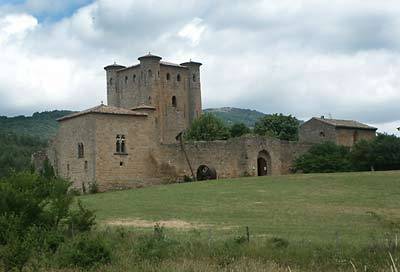
The chateau fortress of Arques, on the road into town.
From a hillside above Arques, I looked down on Rennes-le-Chateau and southward toward the daunting peaks of the Western Pyrenees with Pic de Canigou brooding over a network of icy melodious rivers, Agly, Tet, Tech, Aude, Ariege. I lived there alone for ten months, grieving for a lost friend, dancing to Scheherazade and Miles Davis's Afro-fusion riffs, and sorting out the arcane affairs of my destiny. I discarded four huge plastic sacs of notes and writings. Arques was my ark, the haven of my night sea journey, and vessel of passage to a future world.
In Arques, in a converted shepard's cottage at Perruche du Buis one evening in May 2000, I "attained the Stone" by stabilization of subtle perception of the Organic Light. The ability to recognize the OL and hold it steadily in perception came to me through contemplating what I call the "plaster effect." I had often discussed this perceptual phenomenon with students of The Course, back in Santa Fe and L.A., years earlier. I guided myself to stable perception by a mental exercise, not to be confused with a process of visualization. With the OL, there is nothing to visualize. The living luminosity of the earth is there, right in front of you, welling up within the material mass of sensuously perceived objects. But accustomed as we are to see distinct physical objects, which are particular and local, we do not naturally see the soft white luminosity that buoys up these objects, for that luminosity is non-local and cannot be visually situated in any particular thing.
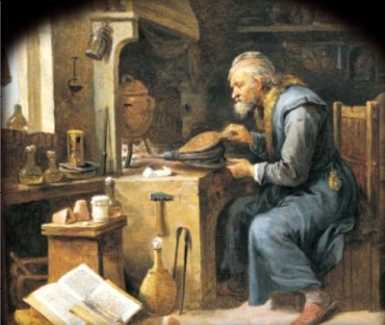
Typical representation of a late Medieval alchemist at his forge, attempting to discover the "Philosopher's Stone." Cramped space and low light in those rustic laboratories may have provided favorable conditions for detecting the Organic Light, which radiates softly through matter in the dark. More likely, long hours of solitude and intense concentration favored perception of the Light. One must wonder: If the OL was the supreme goal of alchemy, why all the foolish talk about curdling metals and tin-pot chemistry? Alchemists who dabbled in chemistry strictly with the aim to produce a metallurgical miracle would perhaps have excluded themselves from the ultimate visionary experience. At the same time, however, perception of the OL might have guided such experiments, giving the adepts direct information about dense matter. Some alchemists of genuine attainment, like von Helmont, enjoyed a dual status: they attained the Stone and produced veracious chemical knowledge. Some of them were also able to convert lead into silver and gold, if there is any truth in the several evidentially supported accounts of such a feat.
From the days of The Course in the early 1980s, I had vaguely sensed that the subtle observation of the Organic Light could be enhanced by contemplating the plaster effect. Yet I did not know exactly what I was investigating at that time! The Course presented about 30 key alchemical motifs and some 75 terms and symbols decoded and converted into descriptive syntax for the "Gaian yoga of the mind and senses." I Example: the Green Lion devouring the sun represents the yogi-alchemist's capacity to detect and engage photosynthesis and live directly off prana streaming in the atmosphere. Significantly, The Course does not assert that the Philosopher's Stone is the Organic Light; rather, it identifies the Stone with carbon. At that time I identified the "First Matter" with oxygen, Azoth with nitrogen, etc. You see how I was mainly concentrating on atmospheric elements rather than metals and substances such as sulphur, stibnite, mercury, etc. Still, it was an enormous omission not to include the Organic Light, the substantial radiance of the Anima Mundi or World Soul, in a practice dedicated to planetary yoga. The key element of my neo-alchemical opus was missing.
The exercise for the plaster effect goes like this: Gaze at normal objects—table, vase, wall behind it—and imagine that everything you see is molded from a single mass of uniform material like plaster. Everything is made of plaster and the plaster is white and soft enough for its texture to be detected, but solid enough to hold the actual form of things. No physical object blurs or dissolves beneath your gaze. Perception remains vivid but seeing or sensing the texture of the omnipresent plaster-like medium is essential for inceptive observation of the Organic Light, and enables stabilization.
The exercise requires a soft gaze, without intent to focus. Letting your eyes move slowly over objects, you register in your mind that everything you see is molded of one uniform block of plaster, as white as snow—first stage of stabilization. Then let your perception register distinct forms such as a vase or a table as stained areas of the plaster. The wooden table of maroon color is not a separate object standing alone in space: it is a form molded from the omnipresent white plaster mass that forms the floor on which it stands, the walls surrounding it, your body. The distinct perceived form of the table is only distinguished as a material object by the color that stains it. Combine the impression of marshmallow-soft texture and the colored stain into a single, abiding perception—second stage of stabilization. This is how the mind can be tricked to allow the eyes to notice the subtle perfusion of the Organic Light through material mass.
The exercise is best done inside at night, in a room lit with low candlelight. The impression that you are sitting inside a set-piece modeled in plaster becomes palpable and unmistakable. With this impression arises a sense of the sweetest tranquillity, a whispering silence of infinite depth. I call this whisper the wooing of the Goddess. Gaia-Sophia woos the attentive visionary who would behold her divine radiance.
Divine Mathesis
In Arques that spring of the year 2000, I verified the plaster effect in a vivid way, so that I could reproduce it later, given the appropriate conditions. Until that moment, I had had only a vague, shifting intimation of the plaster effect. With this confidence, I immediately realized that attending to the Organic Light was like standing in a portal or gateway—and then you enter, you engage. Beholding the Organic Light entails three distinct stages, repeated with each encounter: first, a subtle shift that allows initial detection, second, attendance to the Light, and third, engagement, i.e. stepping through the portal. The shift through these phases comes effortlessly, but the act of attending is fully intentional: you stabilize the encounter by attending properly, just as you would enter a classroom, sit down and get still, and attend to the teacher. Initially you can detect the OL when sitting, but the optimal posture for instruction is usually standing.
In attendance to the Organic Light at Arques, I became instantly aware of a sensation of mental acuity and vastness combined. As if my mind was an oceanic expanse, yet my conscious attention in the moment was only a wave standing at the edge of the ocean. Then, with steady attending, the entire ocean pours slowly and rapturously into the wave. The download begins. With the attainment of the Stone, I became aware that standing steadily in the presence of the Organic Light always produces one and the same effect: a download of information, the living intelligence of the earth goddess. This is theoria in its original meaning, "beholding." This is divine mathesis, "instruction by the Light."
I formulated the Arques download into a terma-like document, The Gaia-Sapiens Exchange. It describes in rather recondite language specific interactions between Gaia and the human subject, interactions that involve conversions of the mind and senses back and forth from the human to the planetary modality. Little did I know it then, but this initial mathesis, my first lesson in instruction by the Organic Light, was preparing me for more intensive and far-reaching interactivity to come. In Arques, the OL took me on as a student. It seems I was directed to the fast lane and prepped for graduate work. I was soon to pass from attendance, the passive download, to interactivity, dialogue and ritual engagement with Sophia, the source of the Light.
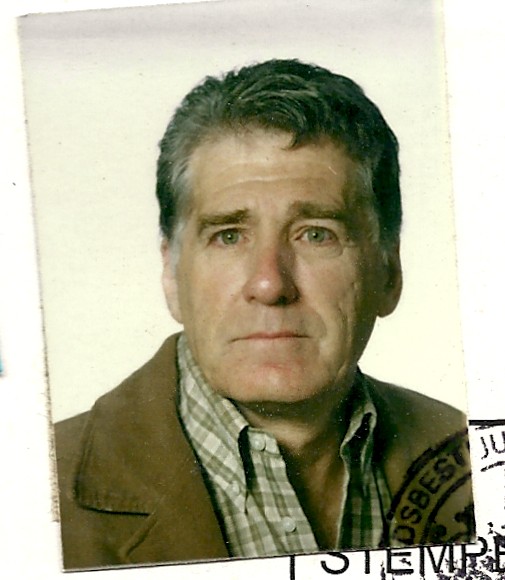
JLL Fall 2001 Oudenaken, Belgium
Yet in Arques I still did not determine in a clear, exact, and verifiable manner that the earth was the source of the Organic Light! What was I waiting for? What was I missing?
In 2001 I knocked off another draft of "Lord of the Clones." I think it must have been the third. 972 pages and 666 footnotes, as I recall. By that time I was delving deeply into Gnostic writings, crawling like a befuddled shit-laden scarab through the dung heap of the Coptic language in search of tasty morsels. I came across explicit descriptions of the Organic Light. Example: The Tripartite Tractate (NHC I, 5), the longest document in the Nag Hammadi Library, says that initiation is a privilege offered by the supreme deity: “The Originator instructed those who searched for higher seeing by means of the luminosity of that Perfect Light” (87: 88.10).2001 : publication of Quest for the Zodiac (written entirely in Belgium)
§ in Cathar Country with Ian Baldwin, Monsegur, on the trail of MM, initial foray into Spain, traversing the Western Pyrenees
2001 June – August : residence at the Groot Beginhof in Leuven, Belgium, for study of Gnostic Coptic books and Dead Sea Scrolls, more work on the Gnostic theory of error and reconstruction of the Sophia myth
2001 November : Marion Institute conference on Gnosticism with Elaine Pagels
§ meeting with Tulku Thondup in Cambridge: I ask him if he thinks that termas can arise outside the Nyingma lineage.
OK, fine. Clear as a bell. But this passage states explicitly that the source of the Organic Light is the Pleroma, the galactic core. I imagine that many people who encounter the OL spontaneously, as can happen at some hallowed moments in life, may assume the like: they are beholding the primal radiance of God, coming from the cosmic source. But the OL isn't that. But then again it is. The above passage is not incorrect: the Organic Light is Pleromic radiance perfused through the realm of the terrestrial elements. Sophia is, after all, a Pleromic divinity. Her morph into the material elements of the earth does no change her divine status. But I anticipate here what only became clear to me somewhat later....
Revelation texts such the Discourse on the Eighth and the Ninth (VI, 6) declare that initiates received knowledge directly from the divine light. The hierophant, the veteran initiate who brings the neophyte into the presence of the Light, declares: “Rejoice over this revelation! For already from the Pleroma comes the power that is Light, flowing over us. For I see it! I see the indescribable depth” (57.25–30). The Sophia of Jesus Christ (III, 4. 20) presents this arresting line: "All natures, starting from the revelation of chaos, are in the Light that shines without shadow, and indescribable joy, and unutterable jubilation." Here in the Coptic writings are explicit descriptions of the active properties of the Organic Light: its depth, the euphoria it induces, the luminosity that casts no shadow, the superearthly radiance that contains all natures, The luminosity of Sophia conveys power (more later on exactly how), it flows over the beholder, it instructs, it presents unfathomable depth... All of which can be verified by first-hand experience. Still, this text makes the source of the OL to be the Pleroma, the galactic core, not a particular Aeon or current of living luminosity detached from the core and tellurically grounded: what Sophia now is.
The G-Spot
So what did it take, finally, for this mystical kid to reach a consummate vision of the local source of the Organic Light, and be able to speak of it with confidence?
2002 May : Infinity Ridge, Andalucia, Spain - conversations with Gaia, Devi Tree, encounters with the Organic Light, dialogue and interactivity, telestic shamanism, cording, ecosorcery
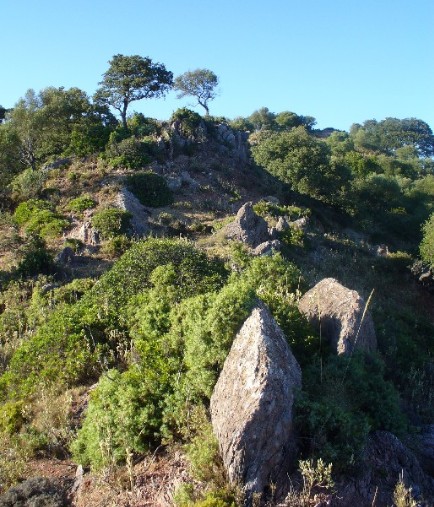
How come at Arques—the alleged burial place of the Messiah, no less!—I was not able to recognize in the Organic Light the primary substance body of the Aeon Sophia? Well, two reasons. First, I did not have her myth installed and operating at full bore, the central act of my imagination, 7/24. Second, the cozy little shepard's house in Arques was not the right place for that recognition to emerge. I needed a specific setting in nature, out in the wild, serene, spectacular, a place where you can scream your head off and no one will be the wiser. I found it two years later when I visited Andalucia for the first time since passing through the region at the age of eighteen, hitchhiking from Algeciras to Paris.
Tertons find things. The best discoveries come without looking, though there must be a long search in preparation for spontaneous discovery. Attention must be acutely primed. Deliberate looking must be prepped for release into the revelation of the immediate. A terton looks hard and long, then finds without looking at all. I found Infinity Ridge in two seconds as I was driven past it on the way to lunch in a town on the Guadiaro River. The Ridge was high up, steeply off to my right so that I couldn't at that moment see the top outline of it. I just knew with a total body hit that it was there. As we sped by, I felt an electric jolt on my shoulder. I noted to the person with me at the time (JHS), "That's the place to go, a power spot. Wow." Later I found the electromagnetism of the dragon line on the Ridge ("hackles" pictured above) to be so strong that I had crawl around on hands and knees at moments, unable to stand upright against the downward pull of the place as it prized upon the iron currents of my bloodstream. The only other place in the world I have felt an EM pull so strong that it literally pulled on my arms was at Santorini, a circular bay over a live volcano in the Aegean Sea.
The name of the Ridge derives, of course, from the boundless view of the Nagual. But also from the topographic form of the dragon hackles in the shape of a huge S that curves around, tail to head.
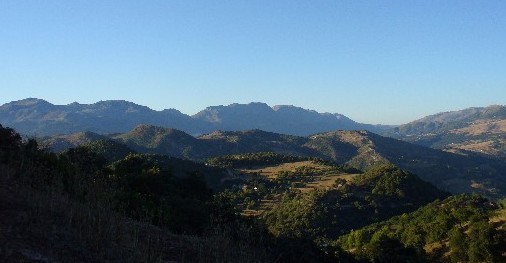
The Ridge affords a view northwest along the east-facing flank of the Sierra de Libar. It was there, gazing in rapture at that vista, watching the nectarine hues of the granite slope modulate with the afternoon sun, that I realized the Organic Light was coming from the planet itself, that it is Sophia's primary substance body as an Aeon, a torrent of mass-free pearl-white nougat-like luminosity coexisting with her sensuous body, the material earth. That consummate perception had to happen in a sacred and solitary place, in the wild. Immersed in the obliterating beauty of those mountains, with the sweet wind from Africa at my back, I first conversed with Gaia, catching the precise tone and intonation she uses to reach me: the voice like a fuming distillation of smoky syrup, soft but resolute. And there on Infinity Ridge, alone and with a few human allies, I discovered and performed rites of interactive magic, the practices of ecosorcery, cordings.
For me, this was the mythical G-Spot, the place to touch with my presence and see Gaia climax in splendor.
On repeated visits to the Ridge, I was alerted to a particular commanding presence indwelling a wild olive cluster, the Devi Tree. Over the years, I came to understand that the Devi Tree was the abode of my guardian and tutelary deity, Devi My Dakini, DMD. I called her DMD in those six years before her traditional, received name became known to me. (She has 1001 names, Hindu tradition says.) I understood that if I knew and pronounced her received name, I could die. I was prevented from knowing it to protect me. A stubborn old rule of sorcery warns against pronouncing certain names aloud. Such are the occult idiosyncrasies of a terton's life. I am a case of walking, talking mythophrenia. What I imagine acts on me as powerfully as the ordinary world does, if not more so. This is an occupational peril of the terton, and a measure of mature, full-bore mythophrenia. It is also the privilege of a nagual who ventures into the Supernatural.

The Devi Tree on Infinity Ridge
Now I understand that death is not due to me for knowing the Devi's name, but total readiness to die comes with literal acknowledgement of life-sustaining magic. So there she is, the witch on the roof, the one who severed the rose: Kali Ma, infernal mother who destroys all illusions, including the illusion of compassion.
Ambika, thou art the dreaming power of Eternity,
The seed spiral wrapping of the Universe,
And the supreme apparition of Maya.
All the universe is bewitched by thee,
But thou, when it pleases you, are the cause of our liberation.
- Hymns to Kali, 11th Mahatmya of Chandi
metahistory.org
2002 July : return from first trip to Andalucia, metahistory.org goes on line, sponsored by The Marion Institute (formerly, The Marion Foundation) until July 2009
§ 2002 November : “SABINA”, my first screenplay, based on the true story of the first mistress of C. G. Jung, the woman who introduced him to alchemy and embodied his muse, his anima
2003 – 06 : elaboration of metahistory.org into the unique source of the Sophianic vision of the Mysteries on the Internet
2006 January 13: World Psychedelic Forum in Basel, 100th birthday of Albert Hoffman. Psychonautics launched on site. Attend with JHS, Dominique Guillet (Kokopelli) who is translating metahistory.org into French
When metahistory.org went on line in July 2002, the world was reeling with debate over The Da Vinci Code. I immediately posted a mass of material on MM showing that the Gnostic profile of the holy harlot was inconsistent with casting her in the role of messiah mom and breed mare of a theocratic blood-line. From summer 2002 for seven years the material posted on the site amounted to about two or three books annually. At the same time, my screenplay urge went out of control so I entered a parallel course of movie writing that continues to this day. In November 2002 I wrote my first screenplay, SABINA, in three weeks, after having researched the life and work of Sabina Spielrein (1885 - 1942) for nine years. This unsung Holocaust heroine, who merits being regarded as the Anne Frank of the Jewish intelligentsia, lived under my skin and haunted me like a lost lover. Among the parallels in our lives was a deep involvement with alchemy, not to mention an obsession with sexual taboo and transformation. My "biographical empathy" with Sabina Spielrein runs extremely deep.
With metahistory.org on line, I had an excellent platform to present the Sophianic vision of the Mysteries, and I went for it with rabidity. As I wrote on Archontic intervention, the origins of the Gnostic movement, and undertook commentaries of 32 or the 52 documents in the Nag Hammadi Library, I continued my shamanic forays to Infinity Ridge. With the Devi at my feet and Gaia looming in the clouds, I came to know what it means to be a nagual. Originally, anthropologists used the term in reference to nagualism, a shamanic practice widespread in Central and South America. The nagual is the shamanic double, the power animal comparable to the cat or crow who accompanies a witch in European folk-lore. Castaneda described in his first book how the Yacqui shaman don Juan shapeshifted into a crow, a typical feat of nagualism.
Capitalized, Nagual means "the unknown, the Underworld, the Supernatural," and in small case it means the person who leads the party in a sorcery adventure. Through Castaneda's serial masterpiece in magical realism, spanning thirty years, 1968 - 1998, the concept of the nagual deepened. What I understood theoretically for years became first-hand reality to me on Infinity Ridge. Every sacred place calls to it a particular nagual, a guardian sorcerer. So the Ridge had called me, actually striking me with an electric bolt on the right shoulder. In my conversations with Gaia-Sophia, transactions of power with the Devi, and experimentations in ecosorcery including cording and improvised rites of healing and divination, I came to realize and enact two elementary propositions of telestic shamanism:
The role of the nagual is twofold : to steady the approach to the Supernatural, and to define syntax.
The gift of the nagual is freedom.
As I pursued my nagualistic adventures in Andalucia, unknown to the world at large and incomprehensible to my colleagues at the time, I continued to write material for metahistory.org. At a furious pace, no less. The original nine-button design of the site morphed into twelve buttons with the addition of such categories as Psychonautics, Star Lore, and later, Living Myth and Rite Action. For years metahistory.org sustained a remarkably high level of traffic for a dense, non-commercial site. Hits hovered between 12,000 and 22,000 per day. The site saw a steady influx of new students and a faithful core-group of students returning to the on-line classroom. On the occasions when I talked on radio shows such as Coast-to-Coast AM, hits reached 275,000 per day. For a teaching site with extremely challenging material, this was a remarkable record, I would guess.
Sacred Ecology
§ 2004 October : last visit to Santa Fe, New Mexico. Writing "DR SAX', my second screenplay, based on the novel by Jack Kerouac
2005 May on : writing the Nag Hammadi Reading Plan
2005 December : futureprimitive.org conceived, designed, and written for Joanna Harcourt-Smith, sponsored by The Marion Institute
§ 2006 April : write the first treatment of 'AMERICAN GRAIL", a screenplay adapting Parzival of Wolfram von Eschenbach to a cowboy 'n injun tale set in the American West in the 1880s
2006 November: publication of Not in His Image (written in Belgium and Spain)
2006 November : Paris Eadwine Psalter
Backtracking a little: in 2005 I set up futureprimitive. org for my long-time friend and colleague, Joanna Harcourt-Smith. I pulled together the format and mission statement of the new site in one afternoon, using images from the southwestern art of Gustav Baumann. I recall immersion in a particularly light, euphoric mood as this project revealed itself. It was born of sheer pleasure, a gift to honor a gifted friend.

Original banner for home page of futureprimitive.org, December 2005
I wrote Not in His Image in 14 months through 2006 and 2007, part in Flanders, part in Andalucia. With the benefit of shamanic experiments on Infinity Ridge, I was finally able to tell the entire narrative of the fallen goddess, the Sophia Mythos, AND identify the Organic Light as the primary substance body of the goddess.
As soon as the final draft was completed, I plunged into An Alternative History of the Grail. Traditionally, tertons have treasures delivered to them in "dakini script" which they must decode and convert into normal language. The script may be seen or heard. Treasure finding is comparable to channeling in that the terton receives a download, but unlike it in the nature of the download. Dakini instruction comes in concise and cogent doses. The script is extremely compressed, like data in a Zip file. Channeled material invariably proliferates, running to volume after volume. The discourse of channeling is distensive, but dakini instruction is intensive. "The pith instructions in Mahamudra should be known from an instruction in concise words," according to a Kaygu saying.
The sum and essence of a terma is the "pith instructions." In a state of heightened attention—possibly due to use of datura inoxia or Tibetan beer filtered through fermented barley, giving it the zing of LSD—Jingma Lingpa received succinct dakini teachings. According to traditional guidelines for tertons, he was required to keep the received wisdom intact, within strict limits. Commentaries added to a terma do not constitute the terma as such, they are accessories, add-ons. Sometimes the terton will add a colophon or a ceremonial prayer of homage to a passage of decoded dakini teaching, always cautious to keep elaboration of the essential message to a minimum. I have tended to follow traditional guidelines in this respect. For instance, the Terma of Gaia Awakening consists of three lines of dakini syntax. All the rest is add-on and embellishment deemed to be suitable for the formal presentation of the terma. Packaging, as it were. The Nyingma JL did the same with his termas.
Commentaries and elaborations may take on the splendid aura of a terma, but they are not terma as such. They are, let's say, tertonic riffs. The Alternative History of the Grail is such a riff, the elaboration of a terma. It is one of my more beloved riffs. The true identity of the Grail is a treasure teaching. I can put it in one sentence:
The Grail sought in medieval times was the encounter with the Organic Light known to adepts of the Mystery cults driven underground when the Dark Ages began.
In the Alternative History I trace the diaspora of the Mysteries from the death of Hypatia in 415 AD to 1250 CE. This in nine chapters. Three remain to be written, coming ahead 650 years to the year 1900. It is extremely difficult to trace what happened to the initiates who carried first-hand knowledge of the Organic Light after the 13th century. Historians such as Frances Yates state that the Mysteries survived in Hermetics, Renaissance alchemy, and Rosicrucianism. I disagree. I believe the thread of continuity was broken and access to the Light temporarily lost, but I have yet to get around to writing that part of the tragic tale.
As it stands now, the Alternative History is unfinished but could perhaps stand as a book, anyway. I am exceptionally proud of this writing because of its originality. To my knowledge, no one has tried to trace the survival of the Mysteries in this way. And those who have written on the subject have not made explicit the identity of the Grail and the Organic Light—nor could they, without knowing from experience what the OL is. This material contains some of my best investigative work, historical backtracking, and mytho-historical parallelism. It also elucidates the entheogenic aspect of the Grail quest, revealed in the adventure of the magic garland in the Gawain episodes. I am thrilled to have been able to get all this down in writing.
While I was developing this subject, and just after Not in His Image came out in November 2006, I went to Paris where I located the Eadwine Psalter. This MS is a terton's delight, a treasure of an extraordinary kind. Tibetan lore suggests that some termas are material objects, such a tiny caskets, or scrolls with magical writing. This rumor goes back to a time in Tibetan history when Bon Po, the indigenous religion of Tibet, was suppressed and persecuted due to the importation of Buddhism from India. It is said that at that time some Bon priests concealed their sacred texts in caves so that the teachings would survive the time of persecution. Thus the notion arose that termas are physical documents, actual parchments or scrolls of some kind.
Well, the Paris Eadwine Psalter is certainly that: a tangible treasure in manuscript form. I consider it to be the unique terma of my treasure-finding adventures, being a ready-made material object I found in a library. The psalter was produced around 1250 at the peak moment of the Grail Romances written by Chretien de Troies, Robert de Boron, Wolfram von Eschenbach and others. The 13th Century was called the "mythogenetic moment" by Joseph Campbell who placed paramount value on the Grail legend as the directive myth for modern humanity. In Creative Mythology, Campbell verges on the entheogenic secret in Eschenbach's Parzival, the significance of the magic garland. I take his exegesis to its natural conclusion, using research on shamanism that was not available at the time he worked on that subject.
My writings about the Paris Eadwine Psalter interface perfectly with the entheogenic material in the medieval legend of the Grail. Lo and behold, that prayer-book full of images of psychoactive mushrooms appeared at the same historical moment as Parzival. In NIHI, I wrote: "Gnosis is the deep ecology of the human spirit." The paramount source of Gnosis is the Organic Light. The flagrant imagery of the Paris Eadwine Psalter reminds us that sacred psychoactive plants served as intermediaries, leading seekers to a rapturous encounter with the Light. Deep ecology is inseparable from entheogenic culture and shamanic practice with psychoactive plants. The opportunity to be led to the Organic Light by plant-teachers belongs to the sacred birthright of humankind.
jll: 20 October 2010 Andalucia


